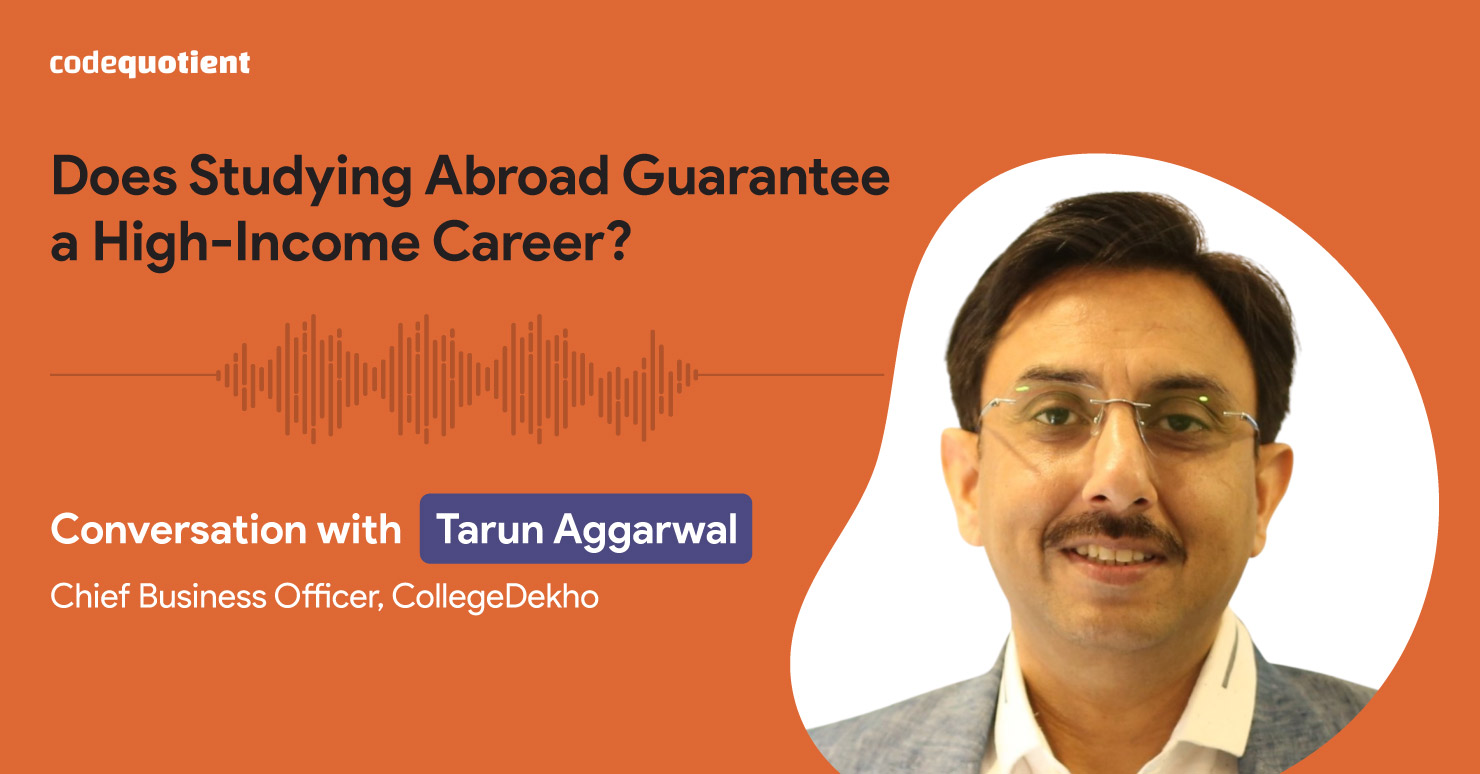As of 2021, 1.9 million Indian students are studying abroad in more than 80 countries. India is one of the biggest players in the international education arena. In the latest episode of Fixing the Bug, Shivangi sits down with CollegeDekho’s Chief Business Officer, Tarun Aggarwal. Mr. Aggarwal presently manages the Study Abroad vertical of CollegeDekho. They talk at length about the nuances, benefits, and challenges of securing education outside India.
Here are some insightful snippets from their conversation.
Tarun Aggarwal’s Journey to CollegeDekho
Mr. Aggarwal started his journey as a telecom engineer. He was instrumental in bringing DVD technology to India during his stint at Philips. He realised his drive to work in impactful areas. This led him to CollegeDekho after spending 15 years in the telecom and IT industry.
Tarun Aggarwal says he is proud to be a product of the Indian education system. That brings us to the first topic – education in India vs abroad.
Challenges of the Indian Education System
The biggest challenge of the Indian education system is volume, according to Mr. Aggarwal. Approximately 37 million students enrolled in higher education in 2020, which has been growing year after year. Combined with infrastructural problems, the sheer number of students is a huge hurdle for India to overcome.
However, Mr. Aggarwal points out that we are not doing as bad as we are made to believe. Despite astronomical volumes, educational institutions in India have carved their niches. But to do this, an educational institute needs time to build its legacy. All the prestigious institutes we see today started their journey decades back.
The issue with the Indian education system is in execution and not policymaking. Mr. Aggarwal says that the National Education Policy (NEP) 2020 is exciting and promising, but only if the implementation is effective.
There are obvious benefits and downsides of Indian education, which brings us to the next subject.
Why are Students Moving Abroad?

Competition
It’s no news that many students from India move to universities and colleges abroad yearly. While we generally attribute it to the quality of education abroad, Mr. Aggarwal says competition plays a more significant role.
The factor of competition makes it difficult for Indian students to get admission into leading Indian universities and colleges. IIT Bombay, for example, accepts 0.2% of the total applicants. It is sometimes much more difficult to get into leading Indian institutes than foreign universities.
Cost
Another factor that comes into play is the cost of education in foreign institutes. At the very outset, Mr. Aggarwal makes it clear that financial capability plays an important role in a student moving abroad. At the same time, the cost of education in several countries has come down, and the gap between tuition fees in India and abroad is not as big as it used to be.
But Mr. Aggarwal reiterates that a student must have the financial means to afford education abroad through education loans.
Return on investment
Education is an investment for most Indians, and there’s sound logic behind it. International education is often seen as an investment that would give much higher returns. Mr. Aggarwal talks about a few things to keep in mind in this regard:
- Don’t conflate Euro or Dollar income in terms of rupees because your expenses would also be in Euro/Dollar.
- Research the country you want to move to. Some countries have unfavourable residency laws for Indians, making it difficult for you to secure a work visa and work in that country.
- The legacy of the institute matters. Not all foreign universities are the same, just as not all Indian universities.
- Some courses have local/national elements in their curriculums. Law, for example, is region-specific. Marketing also has local elements depending on the market you are studying. This is not the case for STEM subjects.
When thinking about ROI on education abroad, we often overlook some common points. But it’s important to consider every factor to get the complete picture.
Considering studying abroad? Here’s what you need to know
There are plenty of resources on the internet on studying abroad, CollegeDekho being among the best. Here’s a quick recap of the basics of studying abroad, as detailed by Mr. Aggarwal in the podcast:
- English proficiency: Proficiency in English is mandatory for studying in the top 4 destinations for Indians – Canada, the USA, Australia, and the UK. Standard tests for measuring English proficiency include TOEFL and IELTS.
- Aptitude tests: GMAT, GRE, and LSAT are some aptitude tests that students must qualify for admission to foreign universities and colleges. Aptitude tests vary depending on the country you want to go to.
- Academic background: A strong academic background is necessary to secure admission to leading foreign universities. Academic performance starting from +2 exams play a role, and so do your undergraduate results.
- Statement of Purpose (SoP) and essay are two important components of getting into colleges and universities abroad. Both the SoP and essay are personalised to get to know the applicant better. If a university cannot differentiate between two candidates on any ground, the SoP and essay will be the differentiators.
- Availability of scholarships also varies depending on factors like merit and socioeconomic background.
Hear more from the top tech leaders in the country on jobs, education, technology, and life – exclusively at Fixing the Bug.




